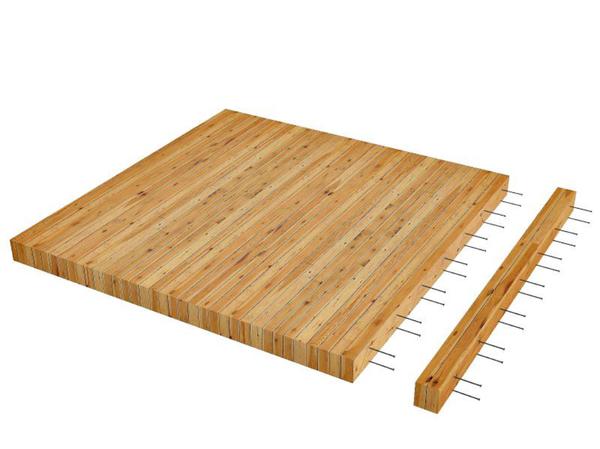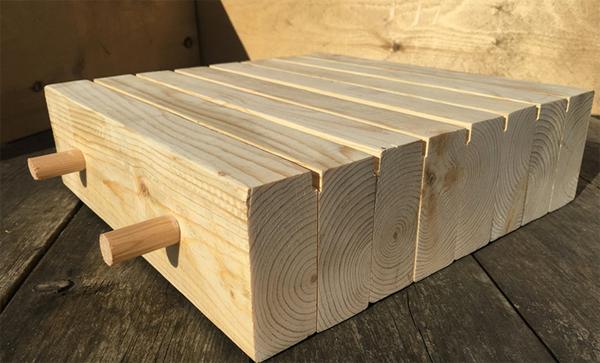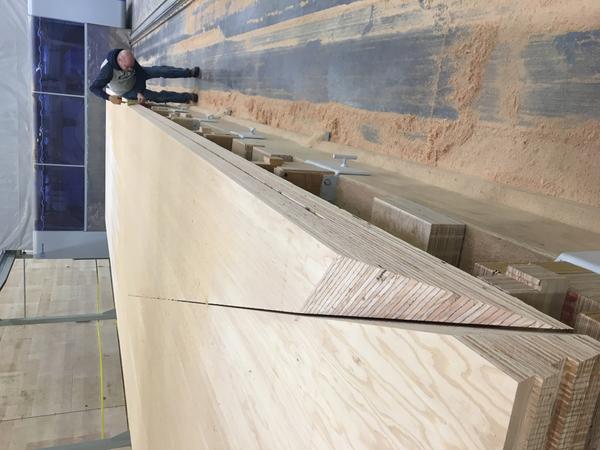Mass timber products, also known as wood-based engineered construction materials, are becoming widely prevalent in the design and construction sector. As a sustainable, carbon-efficient, durable, and modern building option, mass timber construction has already had a profound impact on residential and nonresidential applications in Europe and, more recently, Canada and the United States. Envisioned as a substitute for the traditional building materials of concrete, masonry, and steel, all forestry stakeholders have reason to be excited about the expansion of mass timber usage. The most widespread mass timber product is cross-laminated timber (CLT), which has experienced a rapid upward trajectory in North America in recent years.
CLT Basics
- CLT is an innovative secondary wood product and a remarkable alternative to traditional building materials.
- The CLT concept is like plywood except for the absence of veneer layers.
- CLT panels consist of an odd number of layers (typically three to nine) of dimensional lumber stacked perpendicular to the adjacent layers and then glued together to form structural panels (Figure 1).
- CLT contains only two materials: lumber and a moisture-resistant adhesive.
- Currently, CLT in the United States is made from softwoods. Some initiatives are exploring the use of hardwoods to promote their use and establish new markets.
Over the last thirty-five years, CLT has been used for a wide range of applications globally, including single- and multistory residential buildings, schools, and office buildings. CLT panels are manufactured with lengths up to 60 feet and widths up to 10 feet. These panels are used in structural walls, ceilings, and roofs and in combination with other construction materials. CLT panels are typically prefabricated with precut openings for doors, windows, and stairs.
Why Mass Timber Products?
Mass timber products have several benefits ranging from environmental to social, as listed in Table 1.
Other Types of Mass Timber Products
Although CLT is the most common and widely accepted product, several types of mass timber products are available for architects, designers, and builders for use in residential and nonresidential construction. The various types of mass timber products (Think Wood, 2025) include:
- Nail-laminated timber (NLT): Similar to CLT, NLT panels are created from dimension lumber stacked on edge, but instead of glue, it is fastened with nails or screws to create a larger structural panel. Due to its variety of textured appearances as a substitute for concrete slabs and steel decking, NLT is used in flooring, decking, roofing, and walls, and even in elevator and stair shafts in midrise wood-frame buildings.
- Glue-laminated timber (GLT or Glulam): Glulam consists of individual dimension lumber stacked in parallel layers and then bonded together with durable, moisture-resistant adhesives. With its excellent strength and stiffness properties, GLT is typically used for beams and columns in residential and commercial construction. This product was introduced to the United States in the early 1900s.
- Dowel-laminated timber (DLT): DLT panels are produced from softwood lumber and use wooden dowels instead of adhesives, nails, or metal fasteners to form beams and panels. The dowels are inserted into holes in wood with very low moisture content. Subsequent swelling creates a strong connection between the lumber and the dowels. DLT is particularly suited for horizontal spans in flooring and roofing applications due to its unidirectional grain structure.
- Mass plywood panel (MPP): MPP is similar to CLT, but it is constructed from large-scale plywood panels. It uses engineered veneer and custom plywood layups as a base material rather than lumber. Freres Lumber Company in Lyons, Oregon, manufactures MPP in the northwest United States.
- Micro CLT is a new form of CLT that is used for decorative purposes in interior and exterior applications. The product is made from thin lamella and assembled identically to a three-layer CLT panel. Multiple panels can be connected by tongue and groove. The thickness varies around 0.75 inch (20 mm.)
Current Market Status and Future Prospects
Over the past few years, several current and completed construction projects have created a dynamic movement around mass timber products, in particular CLT. Mass timber’s reputation as a sustainable, durable, and ecofriendly building material has boosted markets for CLT and other mass timber products around the world. Global CLT production in 2020 exceeded 2 million cubic meters (Larasatie, 2020). The global CLT market was valued at $1.2 billion in 2023 and is projected to be valued at $4.1 billion in 2032. North America’s demand for CLT was valued at $179.4 million in 2023, and this region will likely remain the second largest market in the world, after Europe. Consumers are expected to prefer wood-based construction over concrete in the future, driving further market growth.
One example of CLT use is the completed Brock Commons, an 18-story housing complex, at the University of British Columbia. In the southern United States, the Home2 Suites Hotel in Mount Pleasant, South Carolina, incorporates CLT in its flooring system. It is the first commercial project in South Carolina to include CLT. The world’s tallest timber tower, however, is the Ascent in Milwaukee, Wisconsin (Figure 2). The mixed-use building is 25 stories tall and provides 493,000 square feet of space. The use of CLT increases the sustainability of the building and the anticipated green building standard ratings. Similarly, the University of Arkansas has been home to Adohi Hall, a 202,027-square-foot residence hall, since 2019. The five-story residence hall houses 708 beds and a so-called living-learning community. Its floors are made from CLT panels and the columns and beams from glulam. At the time, production capacities were limited and the mass timber products had to be imported from Austria.
The first certified CLT produced in the United States was supplied by DR Johnson Lumber Co. in Riddle, Oregon, in 2015. In 2016, Smartlam, a company in Columbia Falls, Montana, started to manufacture structural CLT and has since established additional capacities in Dothan, Alabama. In Spokane, Washington, Mercer is currently operating the largest CLT press in North America with a maximum size of 12 by 60 feet. Several new companies have established themselves inside and outside North America to cater to these markets. At least one European manufacturer has acquired two softwood mills in the Southeast as a foundation for future mass timber production, particularly in the southern United States.
Initially, Sterling Structural, with locations in Phoenix, Illinois, and Lufkin, Texas, advertised CLT as a matting product (Figure 3) for construction sites. Since then, Sterling has become the largest domestic CLT manufacturer, with a daily capacity of 1,000 panels. With innovative uses across a variety of commercial and residential projects, mass timber will occupy a significant space in the construction industry.
Prospects in North Carolina
North Carolina has about 18.14 million acres of timberland, primarily dominated by hardwoods in terms of number of species, acres of timberland, and live standing tree inventory. Most of the wood and fiber resources available throughout the coastal plains and Piedmont regions have been consumed by several sawmills, pulp, and wood composite plants (for example, oriented strand board (OSB)), and, more recently, pellet mills. Although timber markets for softwood products, particularly pine species, have reportedly performed better compared to the South-wide average, recent timber market trends indicate that both hardwood saw log and pulpwood markets are down substantially in North Carolina. The recent loss of pulp and paper production capacities can have a significant impact on CLT’s prospects, as the wood product industry currently explores new market ventures for available woody feedstock, specifically in western North Carolina. Given that hardwood resources are underused by the existing forest products industry, and low-value wood can be used in mass timber production, raw material availability in the state could provide a huge opportunity for the mass timber industry. Several companies have established production capacities in the South, and the first manufacturer of CLT in North Carolina—Evergreen LLC—recently opened a facility in Stony Point.
Key Challenges to CLT Adoption
- Update and further develop local building codes to recognize CLT as a building material
- Educate the public and construction sector about the seismic and fire performance of mass timber
- Introduce mass timber products to enrich the landscape with environmentally friendly building products
- Create a local supply and demand to reduce and stabilize the cost
- Make CLT and other mass timber products more easily accessible to the public
In recent years, research has resolved many issues associated with CLT. Still today, there are some noticeable barriers to the establishment and expansion of the CLT market in the United States (Mallo and Espinoza, 2015). The greatest barrier for CLT is reported to be its lack of availability in the marketplace, as demonstrated by the need to source mass timber from abroad for Adohi Hall at the University of Arkansas.
CLT meets international building code (IBC) requirements for residential, commercial, institutional, and industrial facilities and is currently being adopted by US state and local building codes to become a standard building material. CLT was approved by the American National Standards Institute in 2012 and incorporated into North American building codes in 2015 as a heavy timber element. In 2021, the IBC was updated to allow a maximum of 18-story mass timber buildings. Similarly, although CLT has excellent performance ratings against earthquake (Izzi et al., 2018) and fire (Kontis et al., 2020; Sandoli et al., 2021), many consumers and construction professionals still fear that CLT buildings are at greater risk of seismic and fire hazards.
It appears that most of these barriers exist due to gaps in knowledge among market participants (Oregon BEST, 2017). Education covering the entire supply chain, including both supply-side (CLT manufacturers) and demand-side (construction sector), is needed to correct outdated misinformation and myths about mass timber products. To many construction professionals, CLT remains a novelty that comes with a perceived incalculable risk. Therefore, creating skilled labor and training architects, engineers, and developers is crucial as well.
Conclusion
The mass timber products industry, primarily led by CLT, is an emerging sector of the forest products industry. It comes with tremendous upside potential in both residential and nonresidential construction in the United States. With several environmental and economic advantages over traditional building materials, CLT has gained momentum in both demand and supply in the United States. The construction sector in the Southeast has experienced tremendous growth in recent years, and mass timber, as an ecofriendly forest product, has a bright future prospect in the United States for the foreseeable future. It’s not the ultimate solution to all of today’s challenges, but it significantly expands the opportunities the construction and housing sector has to offer.
References
Izzi, M., Casagrande, D., Bezzi, S., Pasca, D., Follesa, M., & Tomasi, R. 2018. “Seismic Behaviour of Cross-Laminated Timber Structures: A State-of-the-Art Review.” Engineering Structures 170: 42–52. ↲
Kontis, C., Tsichlas, C., Kolaitis, D. I., & Founti, M. A. 2020. “Fire Performance of CLT Members: A Detailed Review of Experimental Studies Across Multiple Scales.” In Wood & Fire Safety: Proceedings of the 9th International Conference on Wood & Fire Safety 2020. Springer International Publishing (pp. 251–257). ↲
Larasatie, P., Albee, R., Muszynski, L., Guerrero, J. M., & Hansen, E. 2020. “Global CLT industry survey: The 2020 updates.” In World Conference on Timber Engineering (WCTE): Santiago, Chile (pp. 1–8). ↲
Mallo, M.F.L., & Espinoza, O. 2015. “Awareness, Perceptions, and Willingness to Adopt Cross-Laminated Timber by the Architecture Community in the United States.” Journal of Cleaner Production 94: 198–210. ↲
Oregon BEST. 2017. “Advanced Wood Product Manufacturing Study for Cross-Laminated Timber Acceleration in Oregon and SW Washington, 2017.” ↲
Sandoli, A., D’Ambra, C., Ceraldi, C., Calderoni, B., & Prota, A. 2021. “Sustainable Cross-laminated Timber Structures in a Seismic Area: Overview and Future Trends.” Applied Sciences 11(5): 2078. ↲
Think Wood. 2025. “Products and Systems.” ↲
Publication date: June 12, 2025
Reviewed/Revised: June 13, 2025
AG-845
The use of brand names in this publication does not imply endorsement by NC State University or N.C. A&T State University of the products or services named nor discrimination against similar products or services not mentioned.
N.C. Cooperative Extension prohibits discrimination and harassment regardless of age, color, disability, family and marital status, gender identity, national origin, political beliefs, race, religion, sex (including pregnancy), sexual orientation and veteran status.








